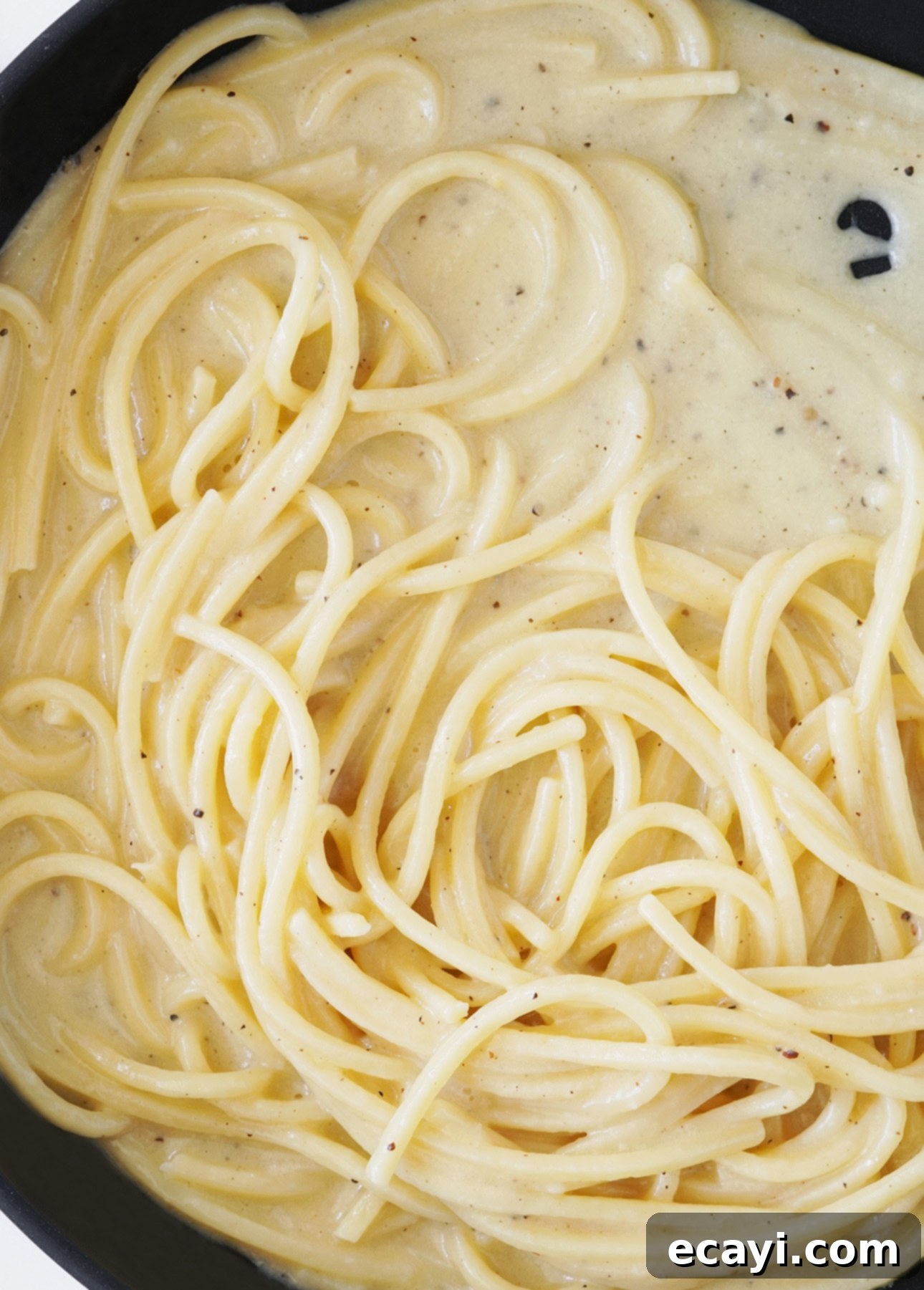Mastering Authentic Cacio e Pepe: The Ultimate Guide to Rome’s Iconic Cheese and Pepper Pasta
Embark on a culinary journey to Rome with this comprehensive guide on how to create the most perfect Cacio e Pepe. This classic Roman pasta, celebrated for its exquisite simplicity, features just Pecorino Romano cheese and freshly ground black pepper. Once famously heralded by the late Anthony Bourdain as “the greatest thing in the history of the world,” Cacio e Pepe is a dish that promises profound satisfaction with every creamy, spicy bite. Discover essential ingredient tips and clever techniques to transform humble components into an unforgettable culinary masterpiece right in your own kitchen.
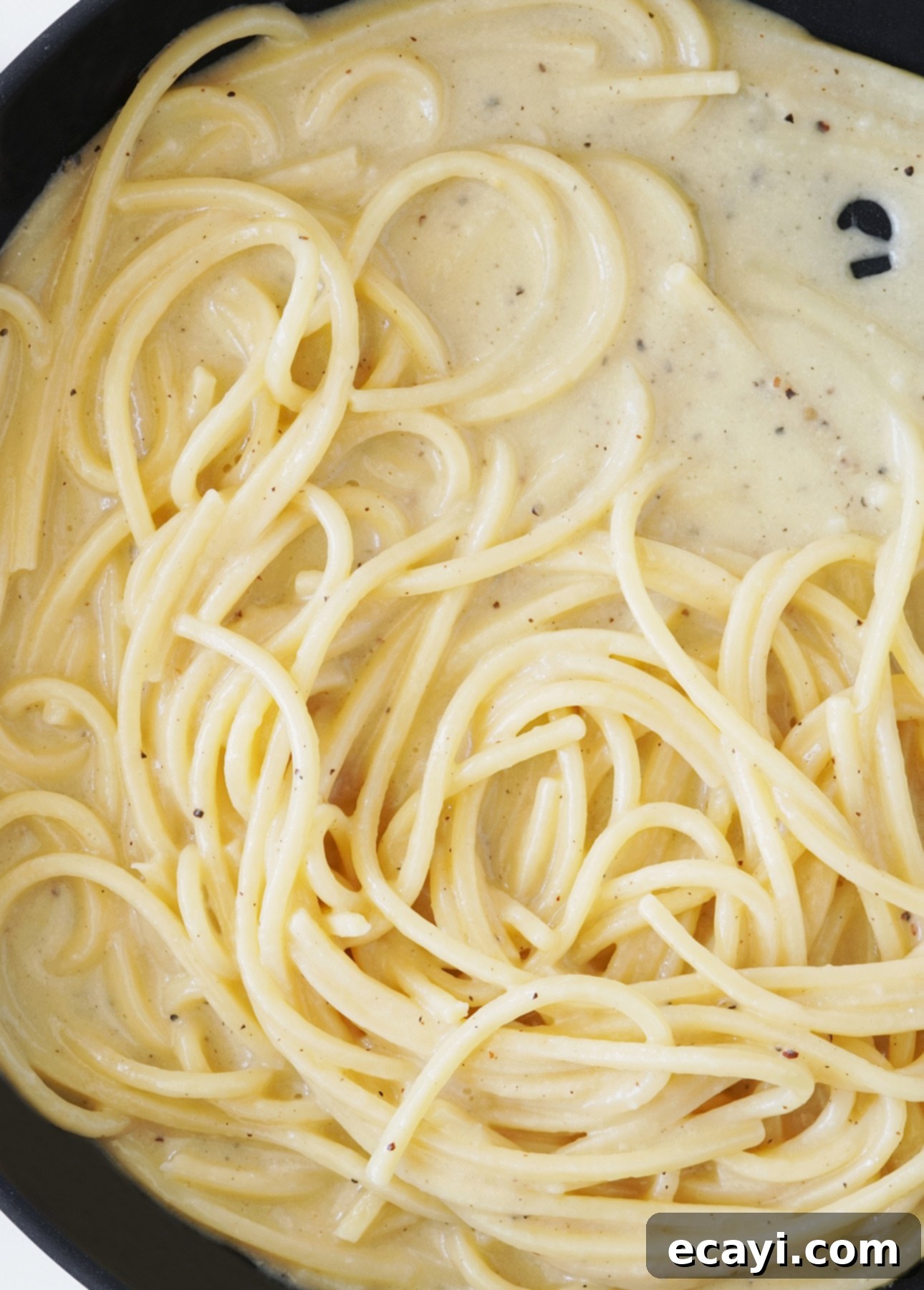
This post contains affiliate links. Full disclosure is at the bottom of the article.
Imagine savoring one of Rome’s most beloved dishes, a culinary experience so profound that it lingers in your memory long after the last bite. What if I told you that this incredibly spectacular dish is also surprisingly simple to recreate in your own home? This rare combination of profound flavor and accessible preparation makes Cacio e Pepe an absolute must-try for any pasta enthusiast.
My own obsession with Cacio e Pepe began many years ago, captivated by Anthony Bourdain’s passionate enjoyment of the pasta in the Rome episode of his show, No Reservations. His unreserved enthusiasm, culminating in his declaration that Cacio e Pepe “could be the greatest thing in the history of the world,” ignited a spark of curiosity that quickly turned into a lifelong culinary love affair. It was clear from his reaction that this was no ordinary dish; it was something truly special.
When I first visited Rome, inspired by that very episode, Cacio e Pepe was naturally the inaugural pasta dish I sought out in the Eternal City. From the very first forkful, I “got it.” This seemingly simple combination of pasta, Pecorino Romano cheese, black pepper, and a touch of olive oil creates an astonishingly aromatic, luscious, and rich experience. It’s a dish that warms you from the inside out, offering a creamy texture intertwined with an ever-so-spicy kick. For many, Cacio e Pepe transcends mere comfort food; it’s often described as mac and cheese for the discerning adult, the ultimate hangover cure, or even the perfect choice for a hypothetical last meal on earth. Its ability to satisfy and delight with such minimal ingredients is truly remarkable.
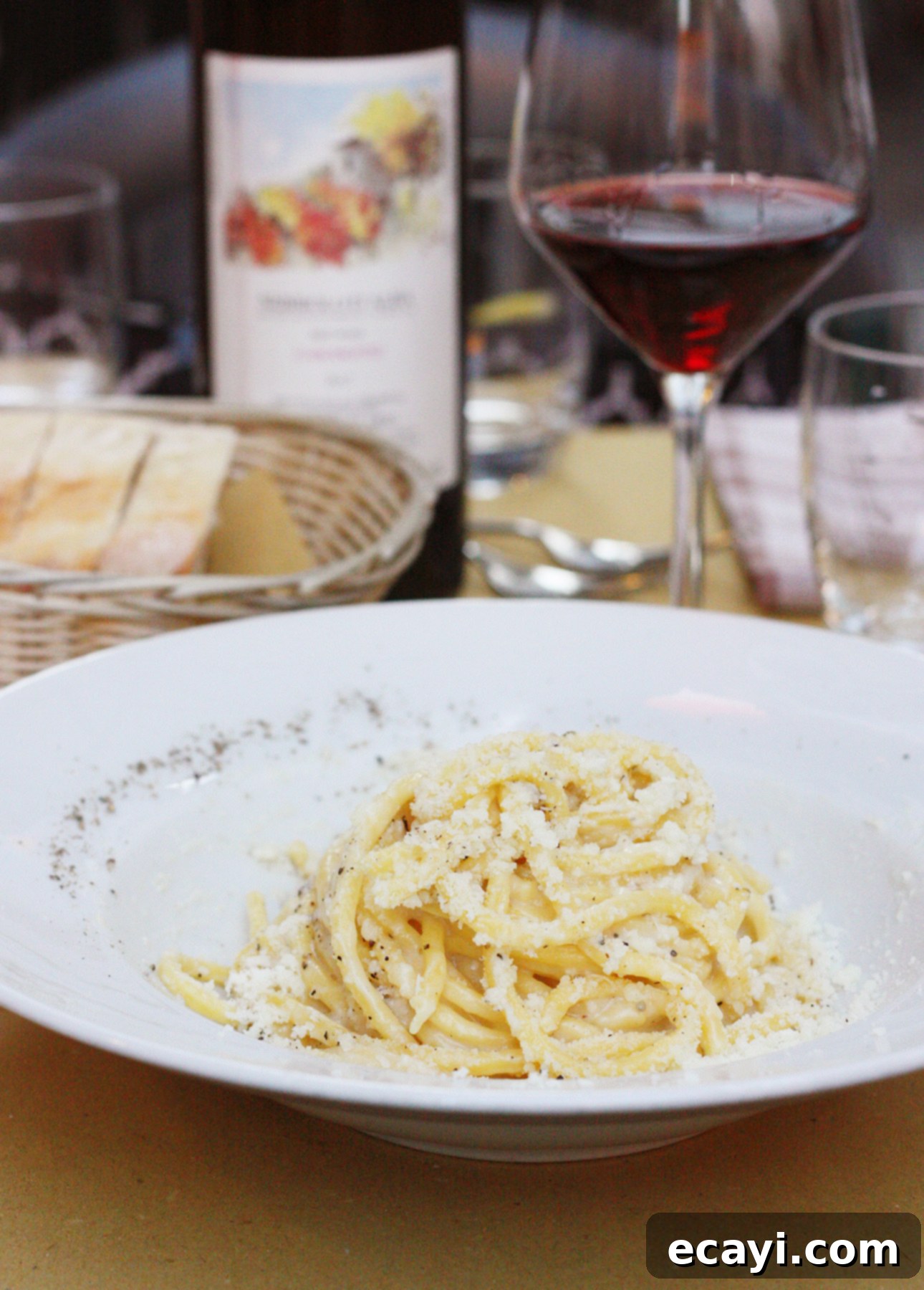
While the bustling ambiance of a Roman trattoria certainly adds to the charm, I can confidently tell you that replicating a perfect bowl of Cacio e Pepe at home offers its own unique and profound satisfaction. It’s a dish that feels incredibly rewarding to serve and even more so to indulge in, especially when you know you’ve mastered its subtle nuances.
The journey to perfect Cacio e Pepe begins with cooking your chosen pasta and gently toasting freshly crushed peppercorns in a quality olive oil. The real transformation, however, occurs as you expertly introduce the Pecorino Romano cheese into the al dente pasta with a splash of starchy cooking water. When executed correctly, the cheese seamlessly melts and emulsifies, forming the most incredibly simple yet undeniably delicious sauce imaginable. This magical alchemy is what elevates Cacio e Pepe from a mere list of ingredients to a truly sublime culinary creation.
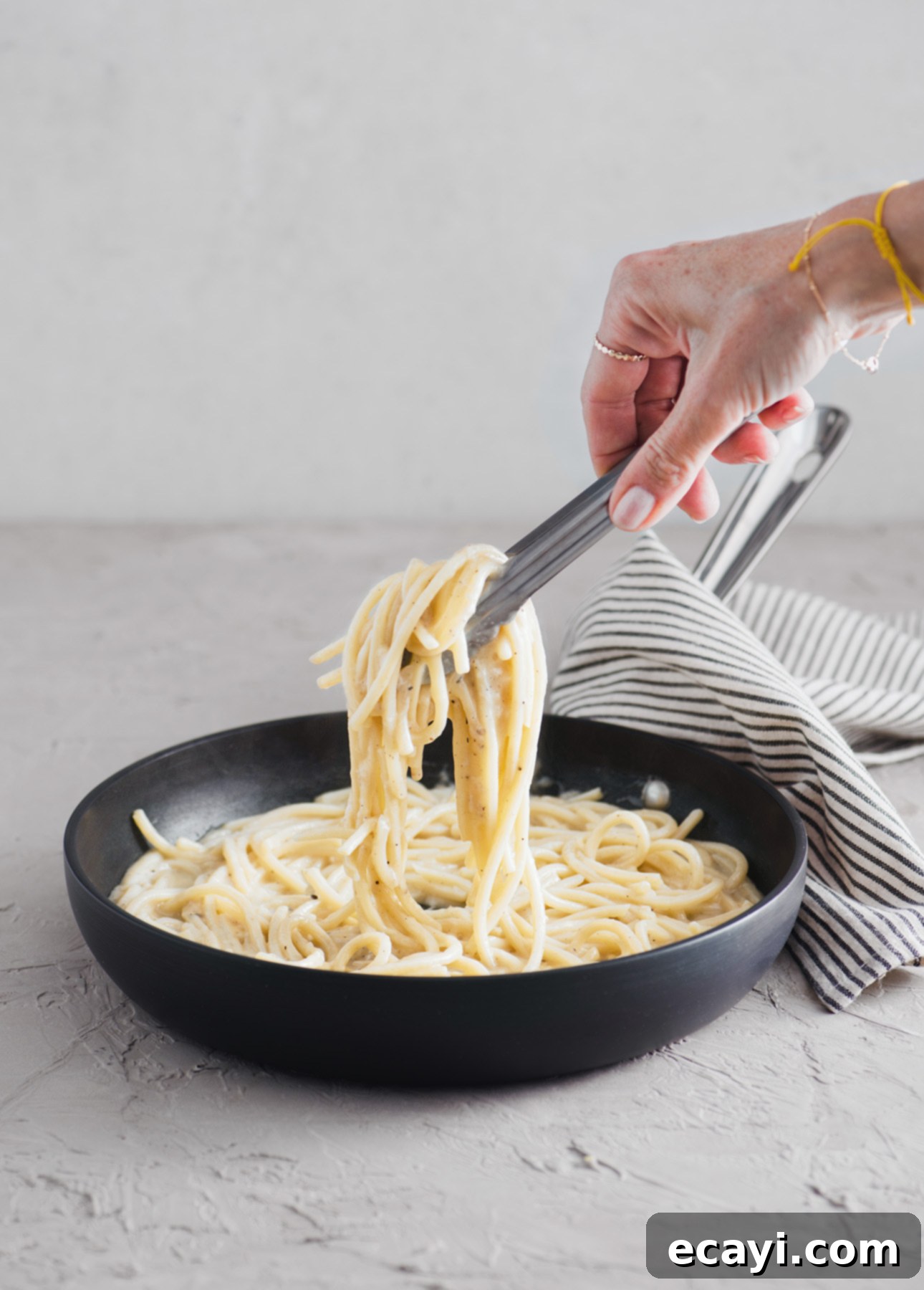
Although Cacio e Pepe epitomizes quick and easy cooking, achieving its ultimate, most perfect version requires familiarity with specific techniques and an understanding of its core principles. Over the years, this dish has become one of my all-time favorites, a staple I prepare almost weekly. I’m thrilled to share all my accumulated wisdom, tips, and tricks to empower you to master this quintessential Italian pasta dish in your own kitchen, ensuring every bowl is nothing short of perfection.
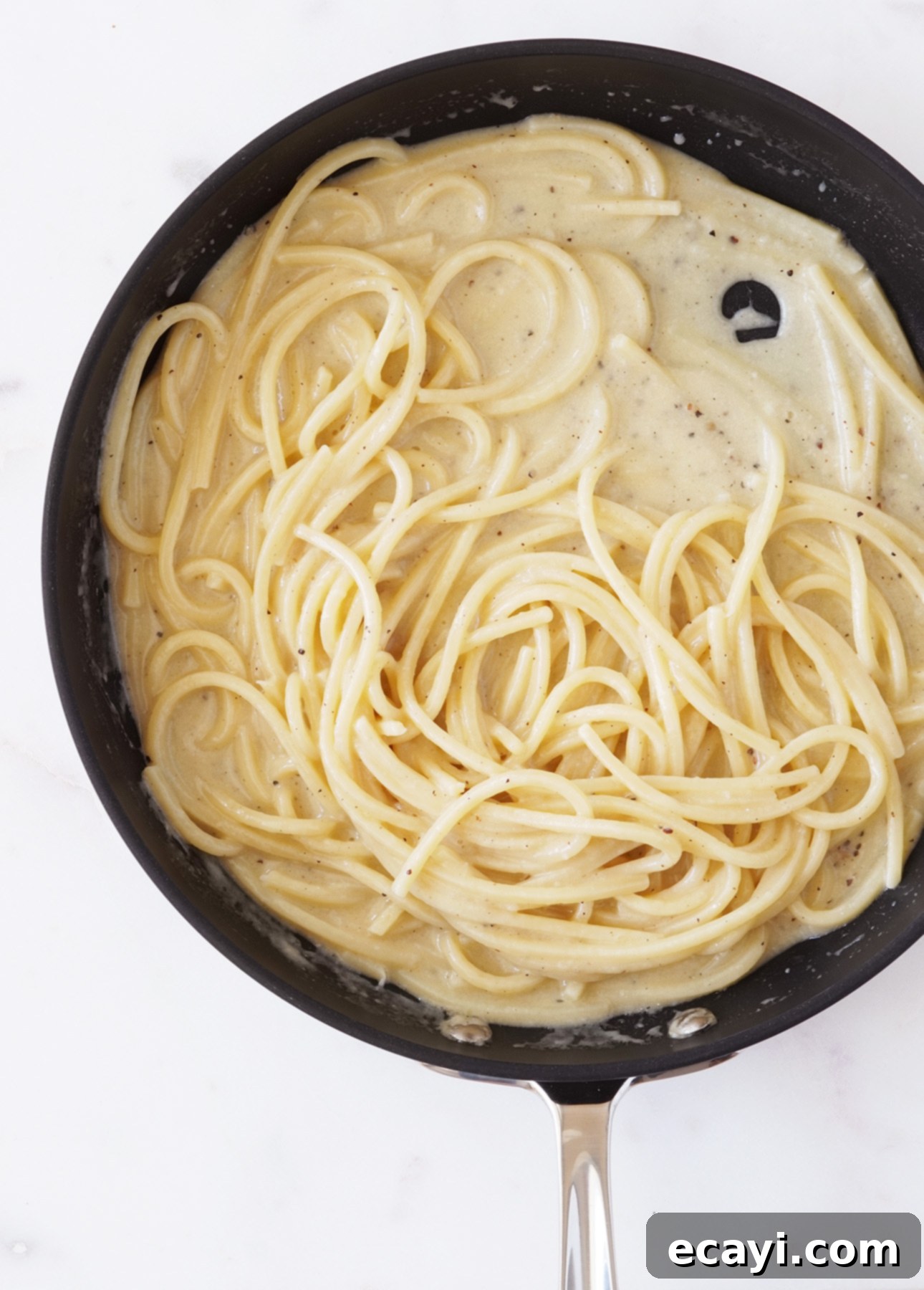
VIDEO: Achieving Cacio e Pepe Perfection
To truly grasp the art of making this iconic Roman pasta, I invite you to watch this engaging video. It provides a visual guide, demonstrating the crucial ingredients and techniques necessary to create an authentic and perfect Cacio e Pepe. Seeing the process unfold can make all the difference in mastering this seemingly simple yet nuanced dish.
Essential Tips for Crafting the Ultimate Cacio e Pepe
Understanding Cacio e Pepe: Name, Ingredients, and Origin
What does Cacio e Pepe mean?
The name “Cacio e Pepe” is beautifully straightforward, literally translating to “cheese and pepper” in Italian. This direct translation perfectly encapsulates the essence of this Roman pasta dish, highlighting its two foundational ingredients. It’s a testament to the Italian culinary philosophy that simplicity often yields the most extraordinary results.
What is authentic Cacio e Pepe sauce made of?
Authentic Cacio e Pepe sauce is a marvel of minimalist cuisine. It is crafted from a precise combination of just four core elements: a touch of high-quality extra virgin olive oil, freshly crushed black peppercorns, a generous quantity of finely grated Pecorino Romano cheese, and crucially, some of the starchy water left over from cooking the pasta. The magic lies in how these seemingly simple components interact, creating a lusciously smooth, cheesy, and aromatic sauce without the need for additional fats like butter or cream.
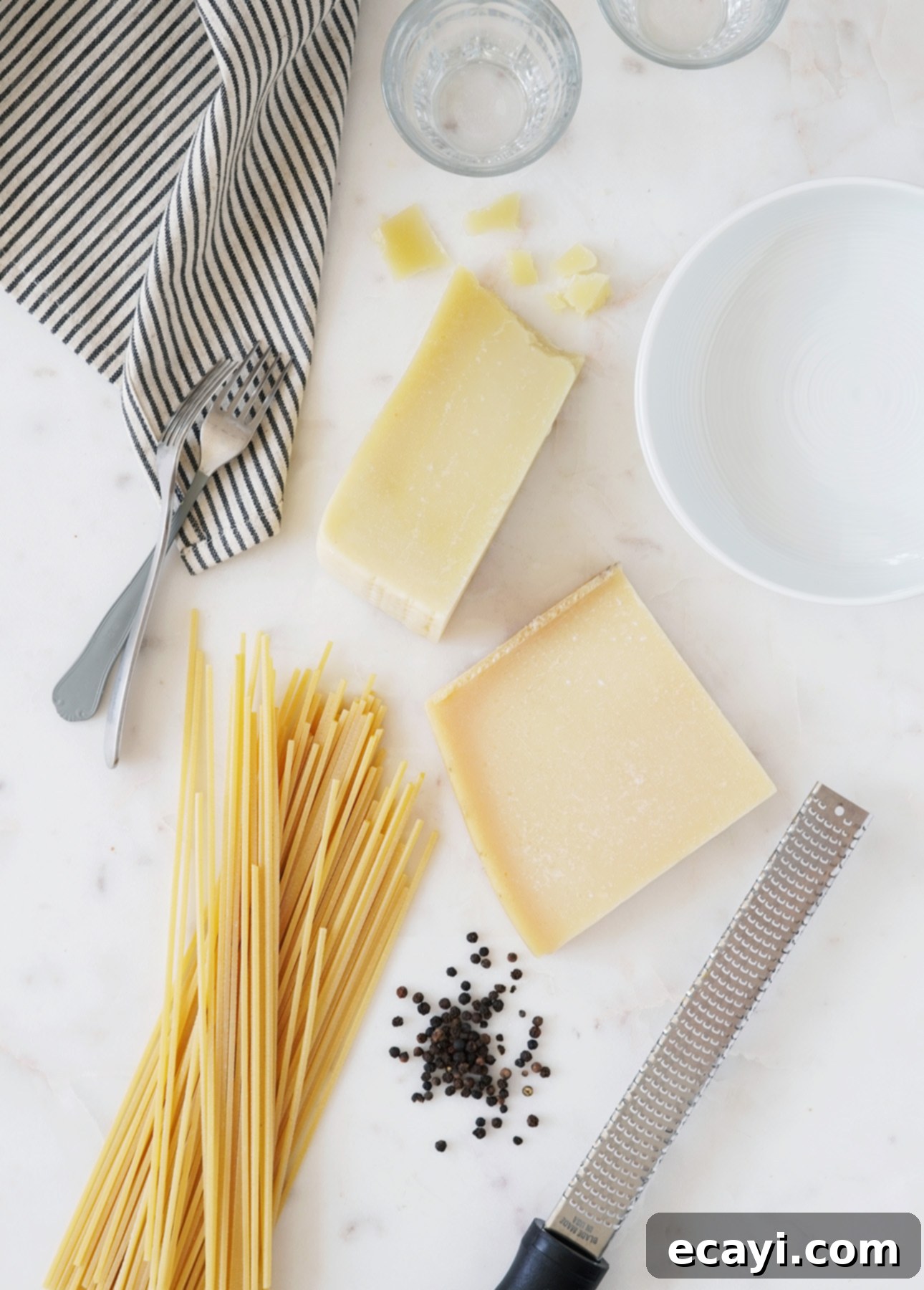
Where does Cacio e Pepe come from?
Cacio e Pepe proudly hails from Rome, Italy, solidifying its place as one of the four iconic pasta dishes inextricably linked to the Eternal City. These culinary pillars include Carbonara, Amatriciana, Alla Gricia, and of course, Cacio e Pepe. Each dish embodies a unique facet of Roman culinary tradition, but Cacio e Pepe stands out for its ancient roots, often associated with shepherds who needed a simple, shelf-stable meal using ingredients readily available on long journeys.
The Secret to Cacio e Pepe’s Signature Creaminess
The unparalleled creaminess of Cacio e Pepe is achieved through the masterful interplay of two specific ingredients, rather than heavy cream or butter. These essential components are:
- Pecorino Romano cheese: A sharp, salty, and intensely flavorful aged cheese made from sheep’s milk. Its unique fat and protein structure are crucial for emulsification.
- Starchy pasta cooking water: As pasta cooks, it releases starches into the water. This seemingly humble liquid is a culinary powerhouse, acting as the emulsifier that binds the cheese and pepper into a silky-smooth sauce. The starch helps to thicken the sauce, allowing the cheese to melt uniformly without clumping and creating that desirable velvety texture that defines a perfect Cacio e Pepe.
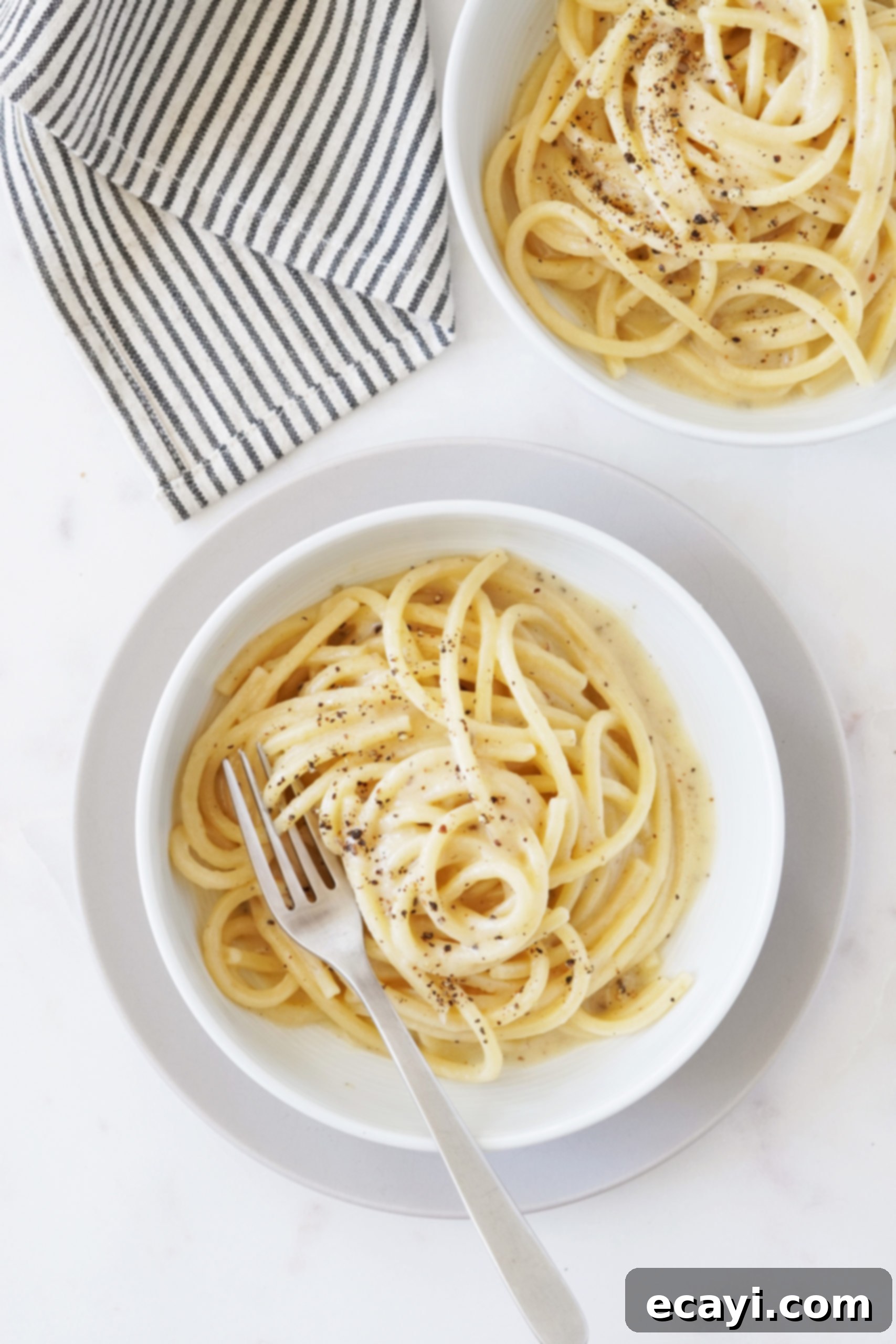
Does authentic Cacio e Pepe contain butter or cream?
A definitive answer: authentic Cacio e Pepe strictly does not include butter or cream. These ingredients are entirely unnecessary when you employ the correct technique. The misconception often arises because many modern adaptations or restaurant versions might add them for extra richness or perceived ease of emulsification. However, the true Roman way relies on the inherent qualities of Pecorino Romano and the starchy pasta water to achieve that rich, silky, and utterly satisfying sauce. My goal here is to guide you in achieving that authentic texture without any unauthorized additions!
Selecting the Ideal Pasta for Cacio e Pepe
The choice of pasta is not merely incidental; it profoundly impacts the texture and success of your Cacio e Pepe. Traditionally, Rome’s preferred pasta for this dish is spaghetti alla chitarra, also known as tonnarelli. This pasta is distinctive for its thick, long, and square-shaped strands, offering a robust chew that perfectly complements the rich sauce. While it might be a bit challenging to locate in standard grocery stores, specialty Italian markets and online retailers typically stock it.
Should tonnarelli be unavailable, suitable alternatives include regular spaghetti (avoiding thinner varieties like spaghettini, as a slender yet substantial pasta with a 12 to 14-minute cooking time is ideal). Other excellent choices that hold the sauce well are linguine and bucatini, both offering textures that stand up beautifully to the creamy sauce.
Left: Tonnarelli (Spaghetti alla Chitarra), the traditional choice; Right: Standard Spaghetti, a widely available alternative.
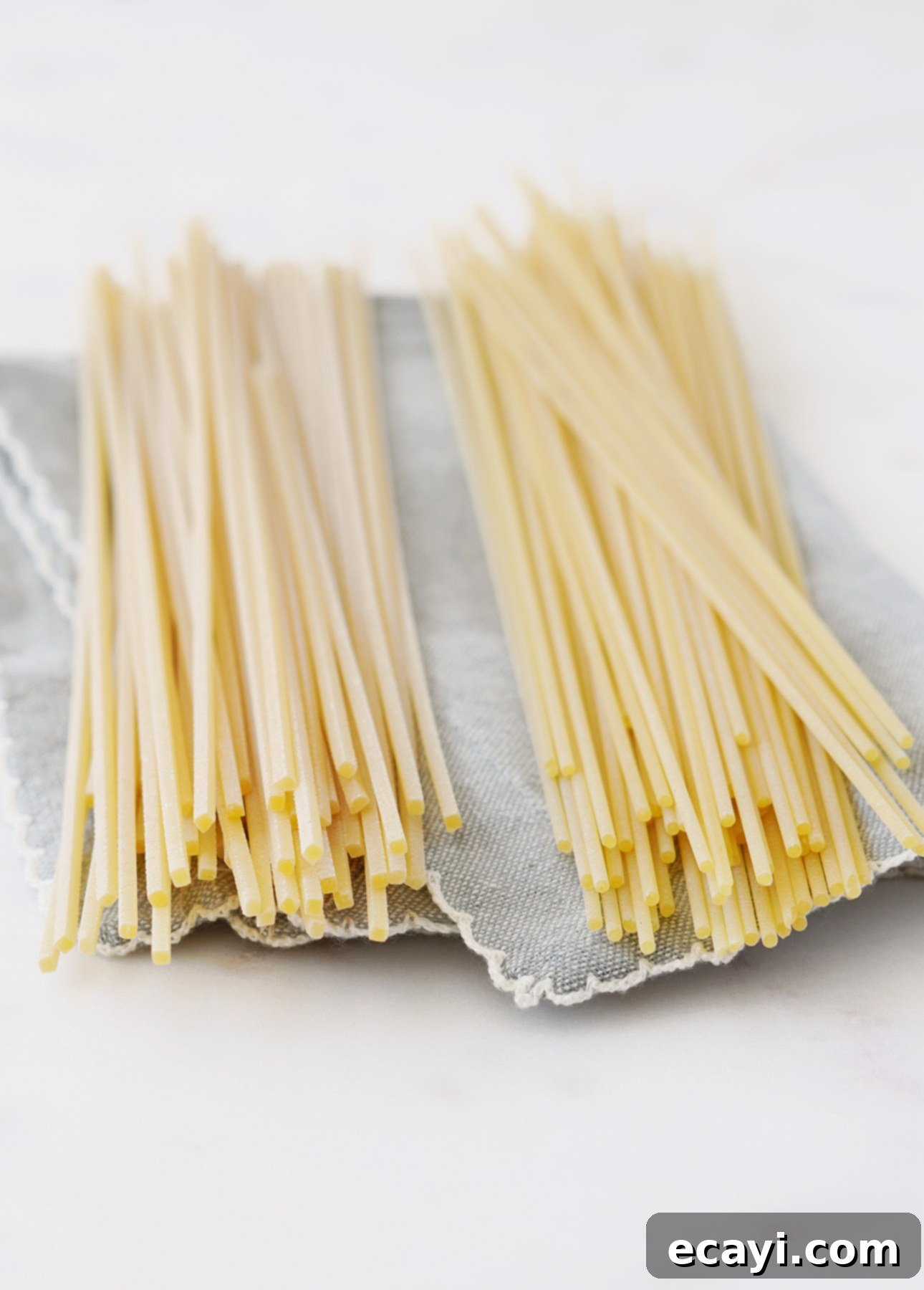
When selecting pasta for Cacio e Pepe, prioritize quality by looking for these two crucial indicators:
1. “Trafilata al Bronzo” – Bronze-Cut Pasta: This label signifies that the pasta has been extruded through bronze dies during its manufacturing process. These specialized metal plates impart a slightly rough, porous texture to the finished noodle. This unique surface is a game-changer for Cacio e Pepe, as it allows the luxurious, creamy sauce to cling more effectively to each strand, enhancing both the flavor absorption and overall mouthfeel. The sauce adheres beautifully, ensuring every bite is rich and satisfying.
You can often find bronze-cut pasta in most well-stocked grocery stores. To identify it, look beyond the major multinational brands towards packaging featuring Italian text. Many artisanal bronze-cut pasta brands are packaged in distinctive, intricately designed paper bags rather than typical cardboard boxes. Even some larger brands, such as Barilla, now offer “artisanal” or “bronze-cut” lines, clearly marked with these terms on their packaging.
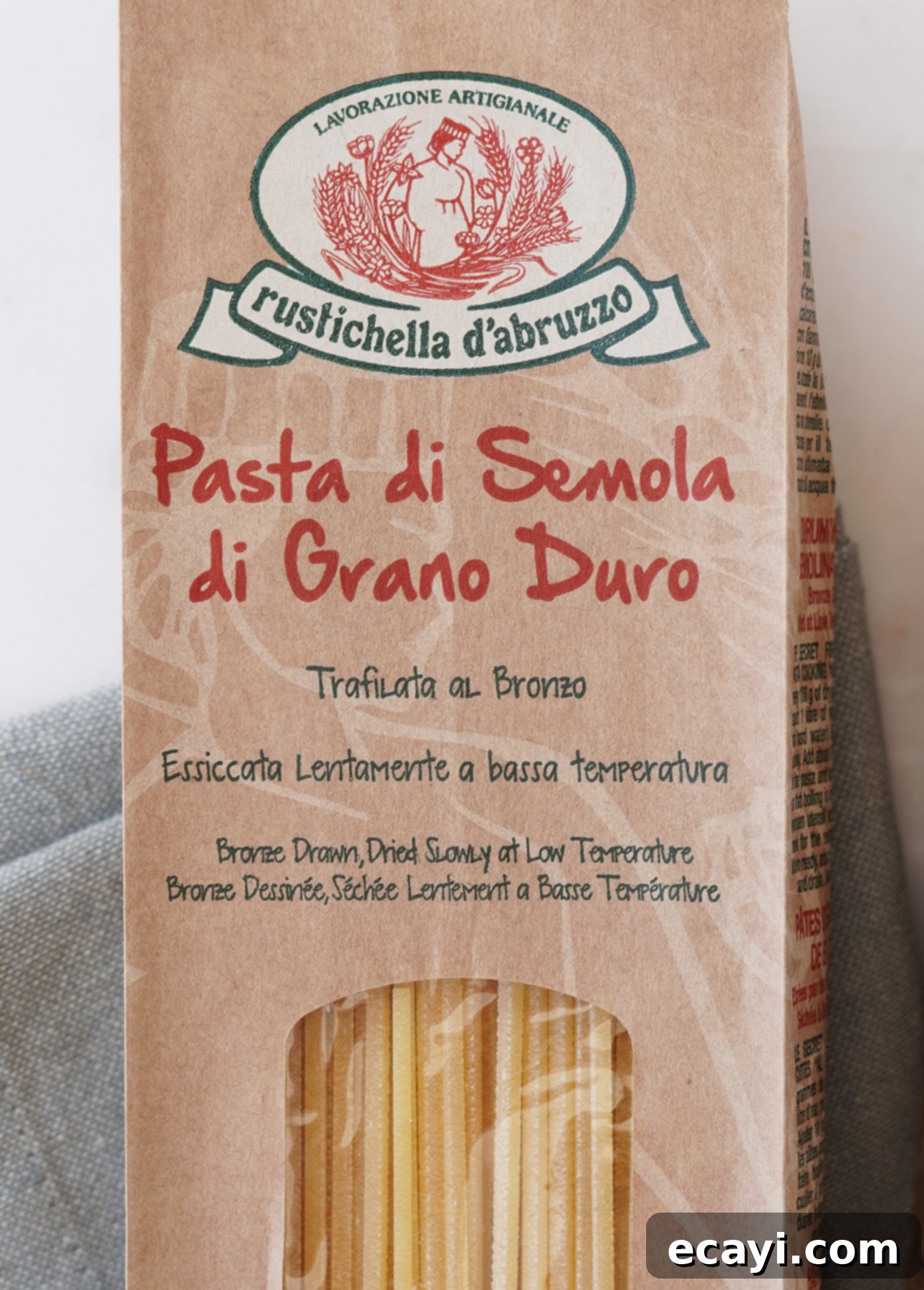
2. “Essiccata Lentamente a Bassa Temperatura” – Slow-Dried at a Low Temperature: The drying process of pasta is just as critical as its shape and cut. Mass-produced industrial pasta is often dried quickly at high temperatures to expedite packaging and distribution. While efficient, this rapid drying inhibits the proper development of the pasta’s starch proteins, resulting in a less desirable texture and diminished flavor.
In contrast, slow-dried pasta, as the name suggests, is dried over a longer period at lower temperatures. This meticulous process allows the starch proteins to fully develop, producing pasta with a wonderfully chewy, al dente texture that is far superior. Furthermore, slow drying contributes to a rougher, almost chalky appearance, which again, significantly improves the pasta’s ability to absorb and hold onto the delicate Cacio e Pepe sauce.
Identifying slow-dried pasta is straightforward: look for packaging explicitly stating “slow-dried.” Alternatively, observe the pasta itself: quick-dried pasta often appears shiny and smooth, whereas slow-dried varieties will have a distinctly rough, matte, and slightly chalky finish. This visual cue often indicates it’s both slow-dried and bronze-cut.
While slow-dried pasta may carry a slightly higher price tag due to the extended production time (perhaps $1 to $2 more per 12 oz bag), this small investment is absolutely justified for Cacio e Pepe. Given the minimal ingredients in this recipe, the quality of each component shines through profoundly. Opting for bronze-cut, slow-dried pasta will undoubtedly elevate your Cacio e Pepe from good to truly exceptional.
The Invaluable Role of Pasta Cooking Water: The Heart of the Sauce
One of the most critical elements in achieving a perfectly silky-smooth Cacio e Pepe sauce is an ingredient you might otherwise discard: the starchy pasta cooking water. This humble liquid is truly liquid gold for Italian pasta dishes, and especially for Cacio e Pepe. As pasta cooks, it generously releases starch into the water, creating a cloudy, slightly viscous broth. This starchy water is absolutely essential for several reasons:
- Melting the cheese: The starch helps the Pecorino Romano melt smoothly and evenly, preventing it from seizing or clumping.
- Emulsifying the sauce: It acts as a natural emulsifier, binding the fat from the olive oil and the proteins from the cheese into a cohesive, creamy sauce.
- Binding the pepper: The starchy liquid ensures the freshly crushed black pepper is beautifully suspended and distributed throughout the sauce.
My preferred technique takes advantage of this “liquid gold” by concentrating the starch. Instead of fully cooking the pasta in a large pot, you’ll cook it halfway through in boiling salted water. Then, using kitchen tongs, transfer the partly cooked pasta directly to a skillet containing the olive oil and black pepper. Crucially, you then add a measured amount of the reserved pasta cooking water to the skillet. The pasta finishes cooking in this much smaller volume of water, intensely concentrating the starch. This enriched, starchy liquid forms the fundamental base for your incredibly creamy Cacio e Pepe sauce.
Starchy pasta cooking water is the secret ingredient for the creamiest Cacio e Pepe pasta!
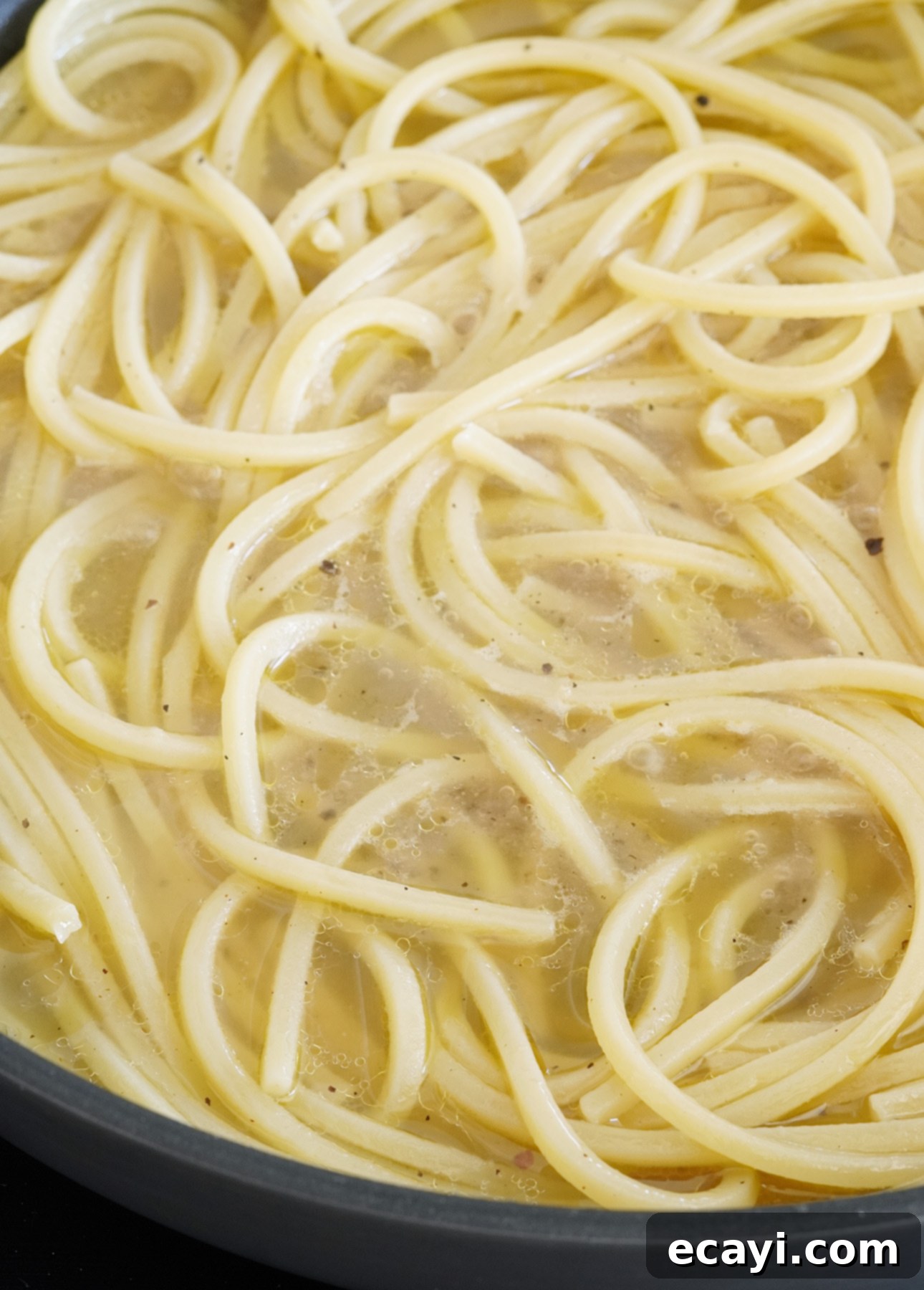
This Italian cooking method is known as risottatura, a technique commonly employed when making risotto. Consider how risotto achieves its signature creaminess even before cheese is added; this is due to the high starch content of the rice, released as it cooks slowly in liquid. The same principle applies when you finish cooking Cacio e Pepe pasta in a skillet: the pasta releases additional starches directly into the minimal cooking liquid, creating a naturally creamy base. It makes perfect culinary sense!
A crucial note: you will achieve significantly superior results, particularly a silkier and more stable sauce, if you utilize slow-dried pasta. Its greater starch release directly contributes to the desired creamy consistency. Revisit my detailed tips on selecting the ideal pasta for Cacio e Pepe here to ensure you’re setting yourself up for success.
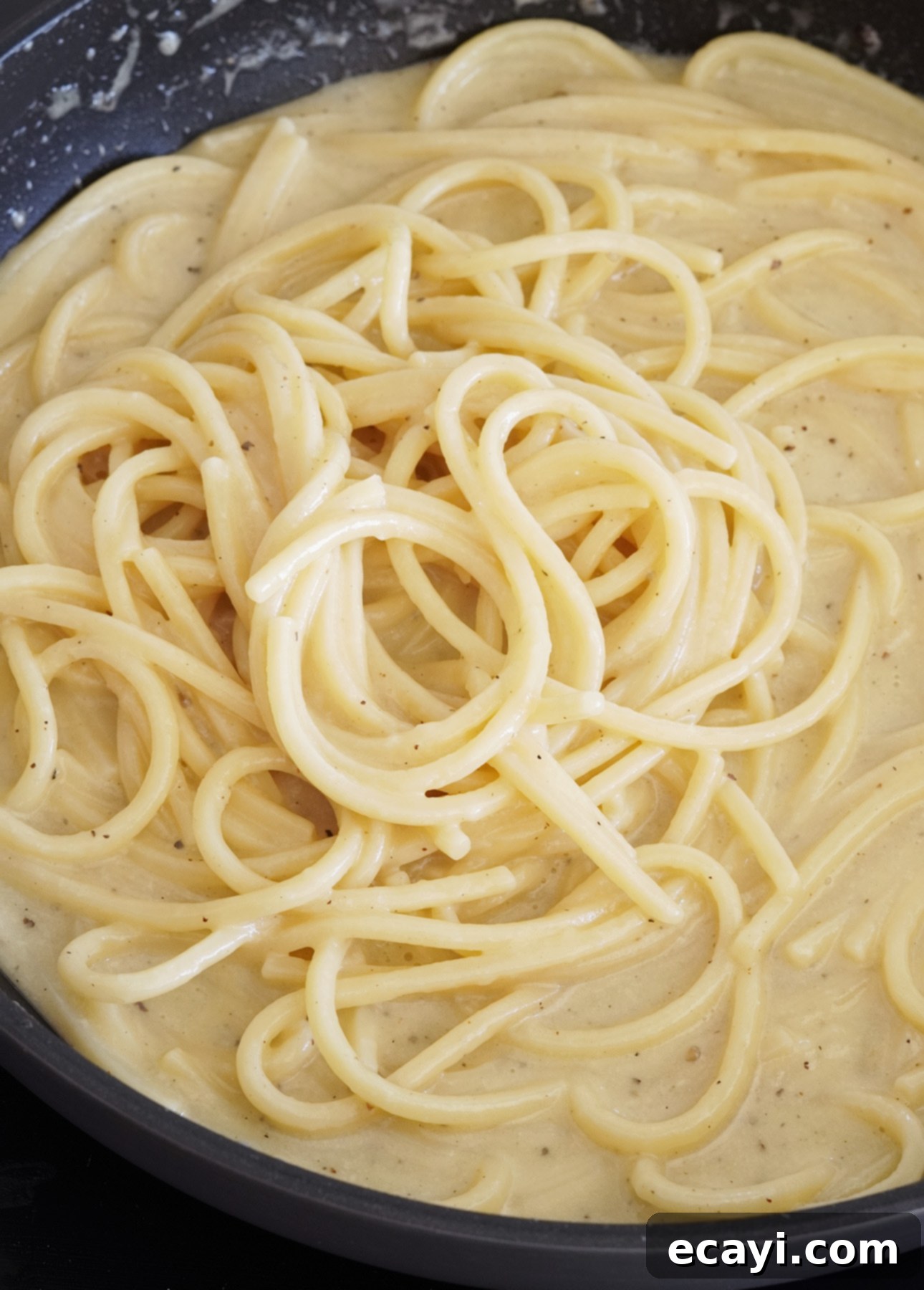
The Indispensable Cheese: Pecorino Romano
In a recipe with such a minimalist ingredient list, the quality and type of cheese are paramount. To create an authentic and truly perfect Cacio e Pepe, there is no substitute for authentic Pecorino Romano cheese. This hard, salty, aged Italian cheese is made exclusively from sheep’s milk. Its origins trace back to Lazio, the region encompassing Rome, making it the historically correct and quintessential choice for this beloved Roman pasta dish. The robust, tangy, and salty profile of Pecorino Romano is absolutely integral to the distinctive flavor of Cacio e Pepe.
Pecorino Romano holds a Protected Designation of Origin (PDO) status, a stringent certification that dictates the cheese must be produced, processed, and matured within a specific geographical area, adhering to traditional methods and utilizing ingredients solely from that region. This ensures its authenticity and unique characteristics. You can recognize genuine Pecorino Romano by its characteristic off-white interior and the distinctive stamped rind, and it’s widely available in wedges at most well-stocked grocery stores and Italian delis.
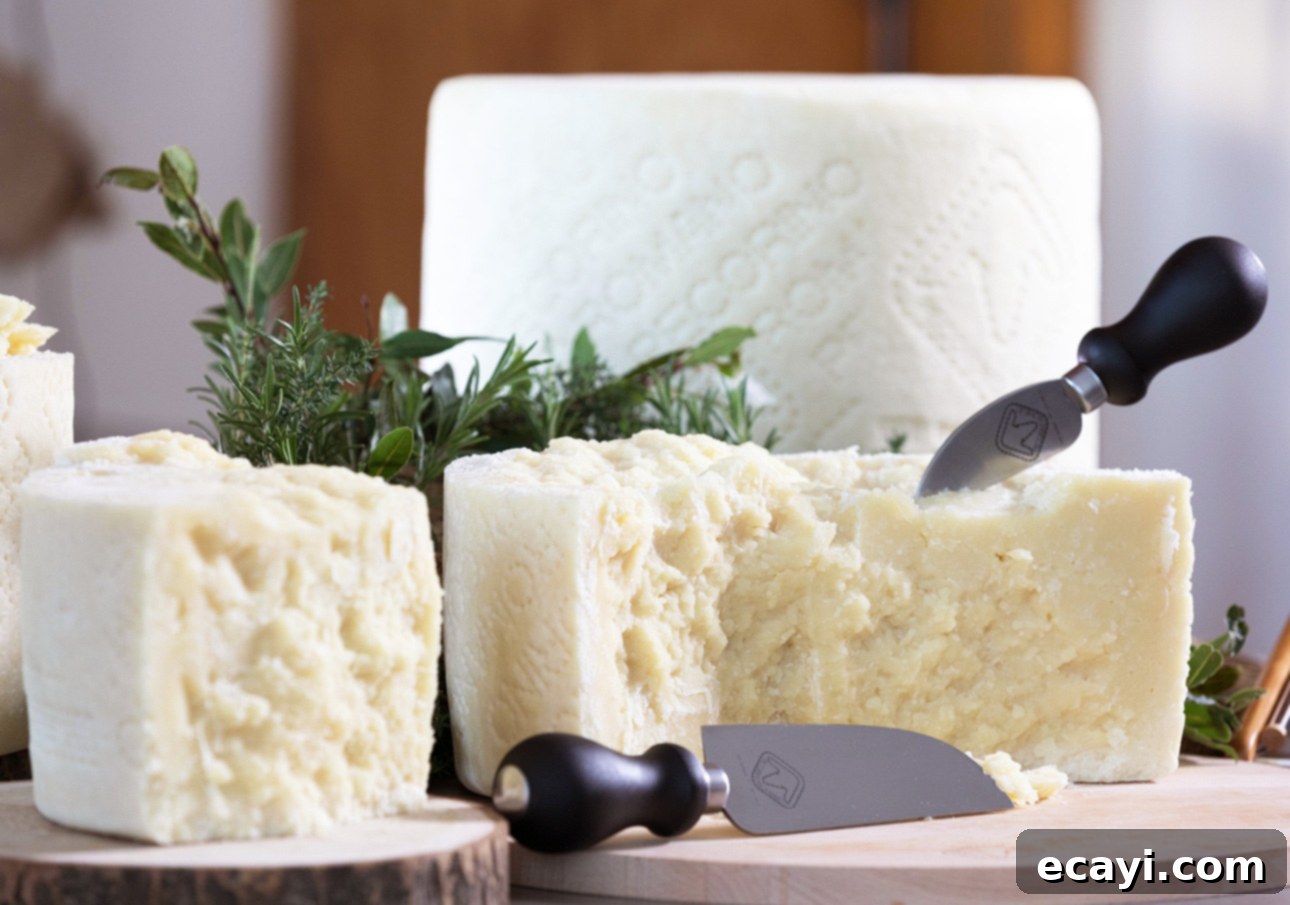
While authentic Cacio e Pepe recipes exclusively feature Pecorino Romano, some chefs and home cooks choose to incorporate a portion of Parmigiano Reggiano cheese. This isn’t traditional, but it’s a common adaptation. Personally, I predominantly make Cacio e Pepe with 100% Pecorino Romano to honor its true character. However, there are times when I enjoy substituting about a third of the Pecorino with Parmigiano Reggiano. This introduces a slightly milder, nuttier warmth and tempers the sharp edge of the Pecorino, resulting in a dish that, while distinct from authentic Cacio e Pepe in flavor profile, is nonetheless incredibly delicious. It’s a delightful variation worth exploring once you’ve mastered the classic.
The Art of Grating Pecorino Romano for a Flawless Sauce
You might be surprised to learn that the method of grating your cheese is a profoundly critical factor in the success of your Cacio e Pepe. Get this wrong, and you risk a clumpy, unappetizing sauce. If the cheese is grated too coarsely, it simply won’t melt smoothly into the pasta and starchy water. Instead, you’ll end up with unpleasant blobs of coagulated cheese. Unfortunately, once this happens, there’s no going back to a silky sauce. While the dish will still be edible (don’t throw it away!), its texture will be far from ideal. Learning the correct grating technique is paramount for achieving Cacio e Pepe perfection.
Through countless experiments, I’ve unequivocally concluded that the finest tool for grating Pecorino Romano for Cacio e Pepe is a Microplane. This specialized grater creates wonderfully fluffy, super-thin wisps of cheese, almost like fine snow. When these delicate cheese particles are gradually introduced to the hot, starchy pasta, they dissolve seamlessly, integrating into a perfectly smooth, velvety sauce that coats every strand of pasta beautifully.
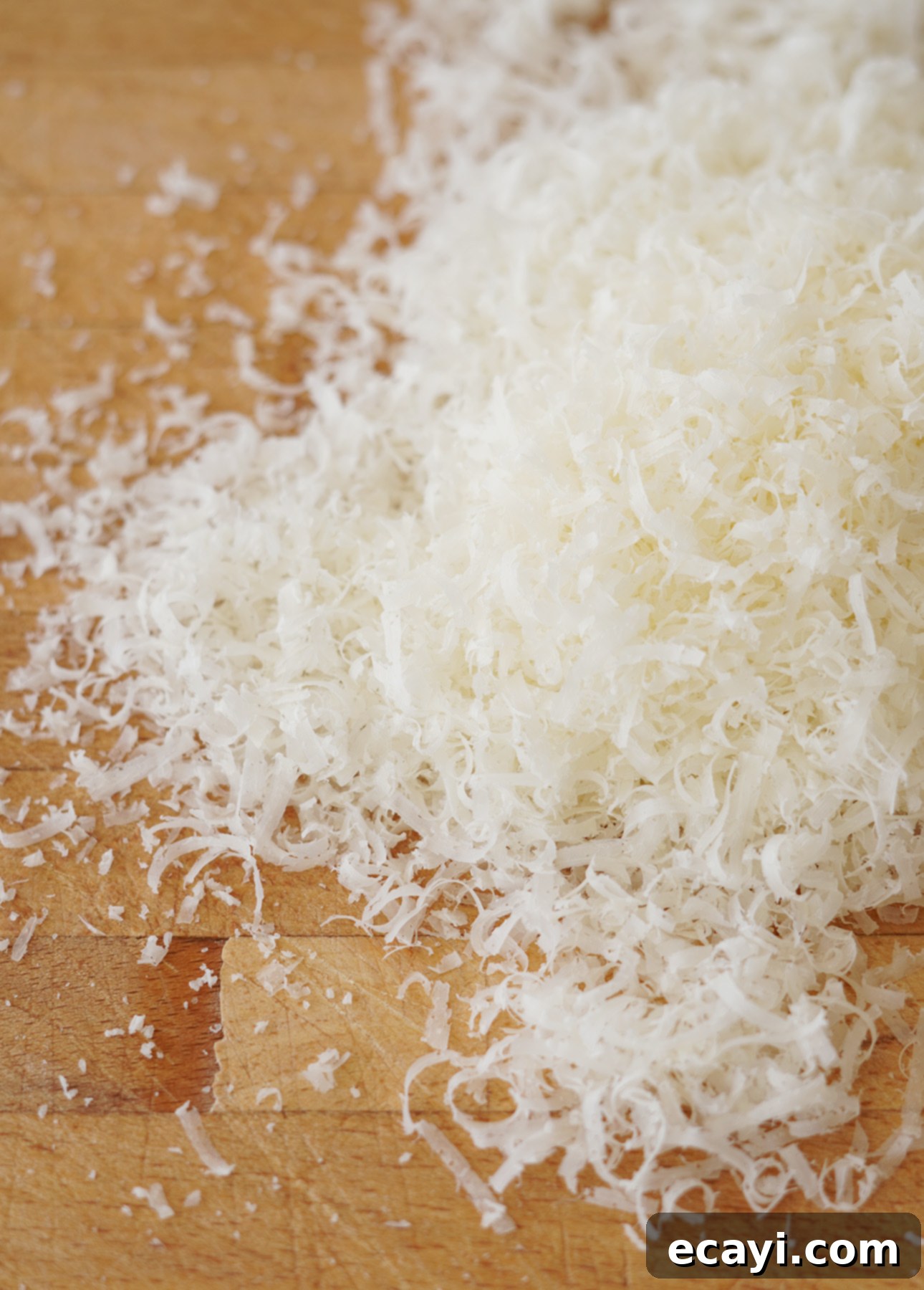
While pre-grated cheeses offer convenience for some dishes, I strongly advise against using them for Cacio e Pepe. These cheeses tend to be drier and resist melting smoothly. Furthermore, they often contain anti-clumping agents (such as cellulose), which will undeniably compromise the texture and emulsification of your sauce, leading to a gritty or grainy result.
My unwavering recommendation: Always purchase a fresh wedge of authentic Pecorino Romano cheese and grate it yourself, ideally using a Microplane, just before you intend to cook. Adhering to this simple but vital tip will significantly increase your chances of producing consistently perfect, silken bowls of Cacio e Pepe.
Precision in Measurement: Weigh Your Cheese
When it comes to Cacio e Pepe, accuracy in cheese measurement is crucial for achieving the right balance and consistency. Attempting to measure cheese in volumetric cups, especially finely grated cheese from a Microplane, is incredibly imprecise. Microplane-grated cheese is exceptionally light and fluffy, making it impossible to pack consistently into a measuring cup for an accurate reading.
Therefore, to ensure precise and repeatable results, always weigh your Pecorino Romano cheese. A kitchen scale provides the exact measurement needed to maintain the delicate balance of this minimalist dish, guaranteeing that your sauce has the ideal richness and body every time.
Foolproof Methods to Prevent Cheese Clumping in Cacio e Pepe
The fear of a clumpy, uneven cheese sauce is a common concern when making Cacio e Pepe. However, with these three indispensable tips, you can confidently achieve a beautifully smooth and emulsified sauce every single time:
- Finely grate your cheese using a Microplane. As previously emphasized, finely grated cheese is paramount. Its delicate texture allows it to dissolve effortlessly into the hot, starchy liquid, preventing any stubborn clumps from forming. Coarsely grated cheese struggles to melt uniformly, leading to undesirable textural inconsistencies.
- GRADUALLY incorporate the cheese into the pasta. This is arguably the most critical tip for preventing clumps. Never be tempted to dump all the cheese into the skillet at once; this is a sure-fire way to create a lumpy mess. Instead, take generous pinches of the finely grated Pecorino Romano and sprinkle them evenly over the entire surface of the pasta. Immediately begin stirring vigorously with a spatula, or even better, rapidly toss the pasta in the skillet, until that initial addition of cheese has fully melted and integrated into the sauce. Only then should you add the next pinch. Be patient and methodical with this process; it typically takes a couple of minutes but is essential for a smooth finish.
- Maintain a gentle simmer throughout the cheese incorporation. The pasta cooking water in your skillet should be actively simmering—but not violently boiling—as you begin to add the cheese. This consistent, moderate heat, combined with your constant stirring or tossing, is vital. It provides the perfect environment for the cheese to melt slowly and emulsify properly with the starchy liquid, creating that coveted silken sauce. If the liquid cools too much, the cheese won’t melt correctly and will clump.
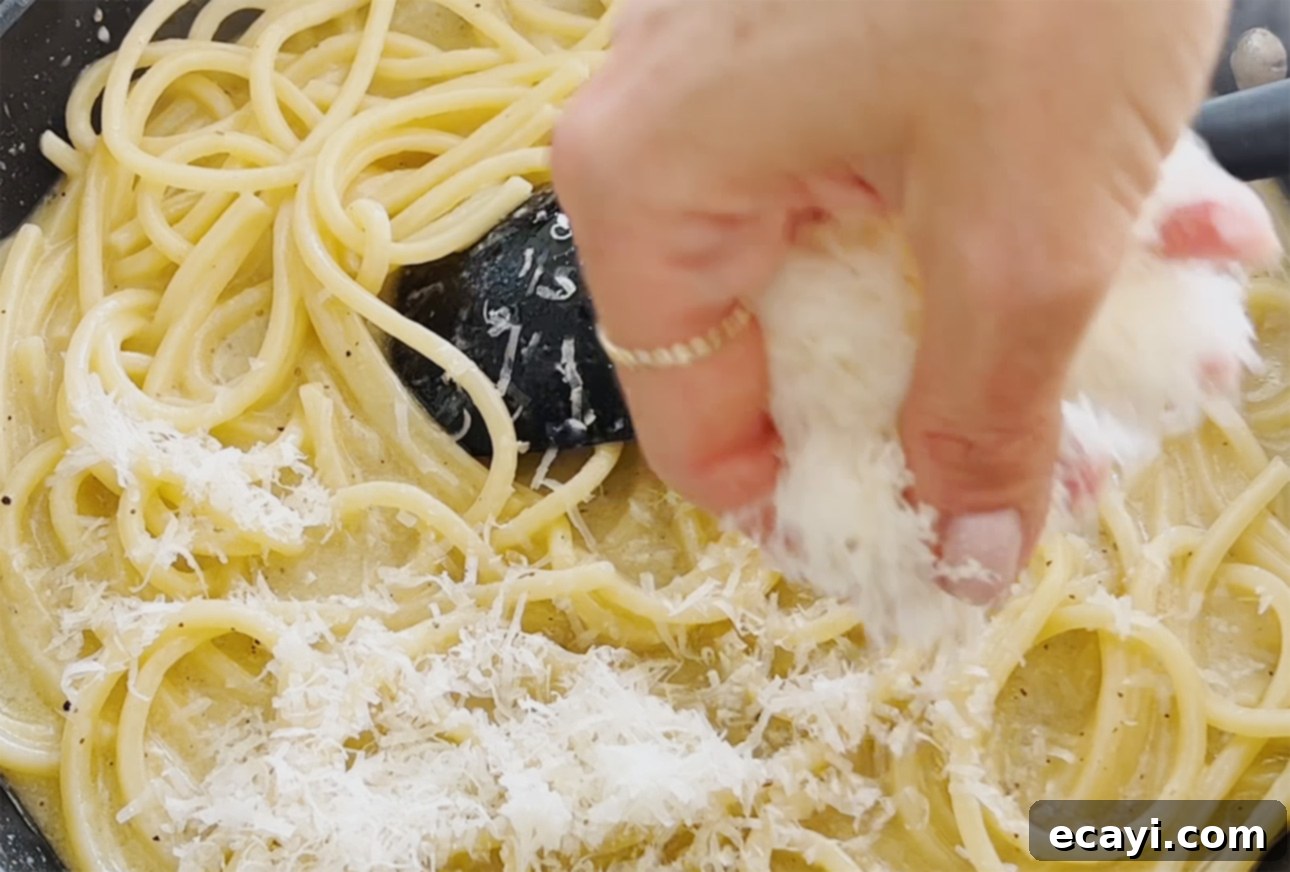
For the Richest Flavor, Start with Whole Peppercorns
Black pepper is not merely a seasoning in Cacio e Pepe; it’s a co-star. To truly achieve the dish’s signature bold and aromatic flavor, you need coarsely ground black pepper, not the fine, powdery variety. For an unparalleled depth of flavor and texture, always start with whole black peppercorns. Lightly crush them yourself using a mortar and pestle, or even a rolling pin, just before cooking. Freshly crushed peppercorns release their volatile oils and full, pungent aroma directly into the olive oil, contributing immensely to a more complex and tastier Cacio e Pepe.
For an extra layer of peppery deliciousness and a beautiful presentation, remember to crush an additional amount of peppercorns to sprinkle generously over the finished dish right before serving. This combination of cooked, mellowed pepper within the sauce and fresh, vibrant pepper on top creates a delightful contrast and allows Cacio e Pepe to fully unleash its enticing, multi-faceted aromas.
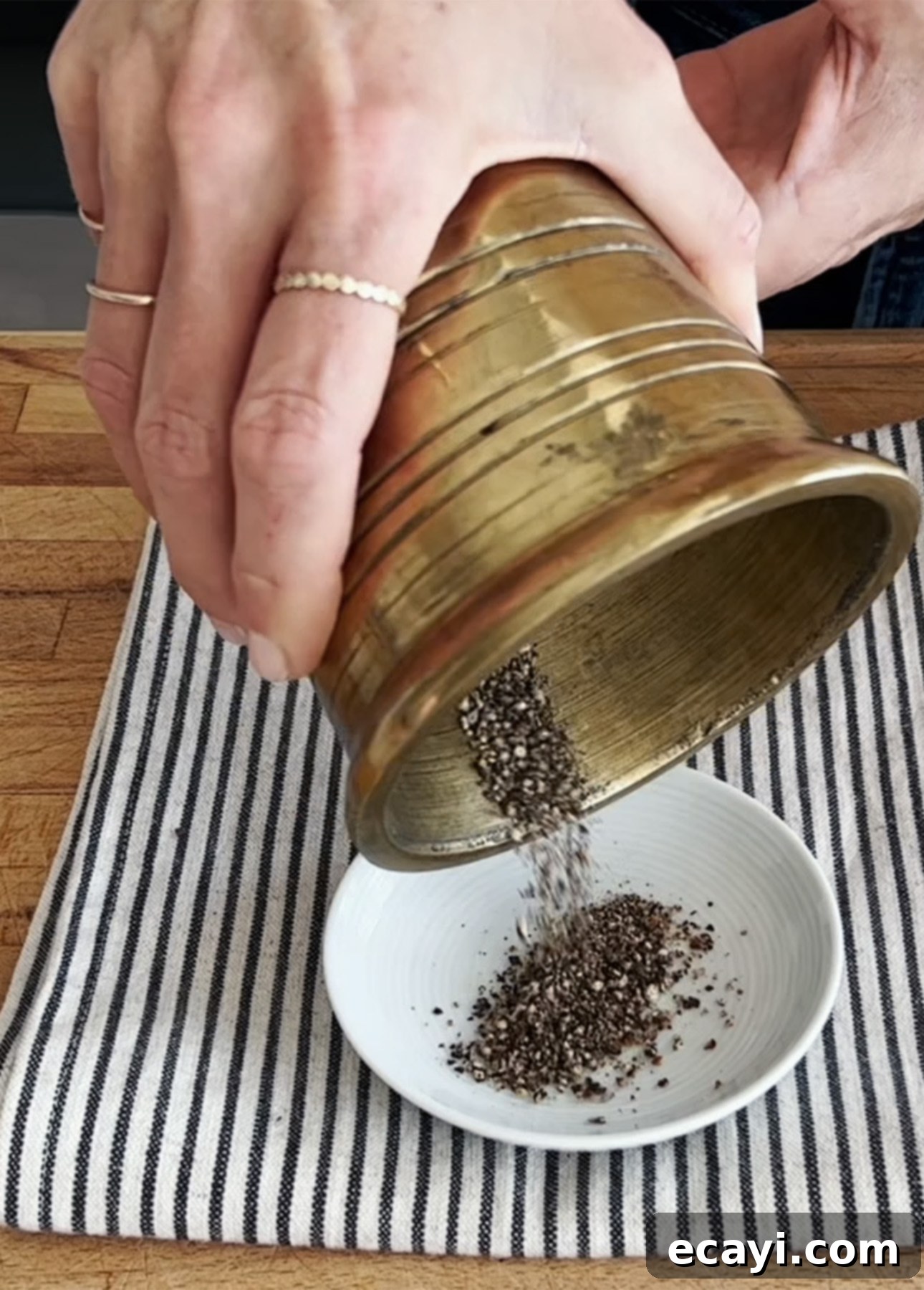
Is Cacio e Pepe a Vegetarian Dish?
Absolutely, traditional Cacio e Pepe is a naturally vegetarian dish. Its authentic recipe relies solely on four core ingredients: pasta, Pecorino Romano cheese, black pepper, and olive oil. There is no meat involved. While you might occasionally encounter modern interpretations that include fried pancetta or guanciale (cured pork cheek), it’s important to recognize that these additions deviate from the authentic Roman preparation. For a true taste of this classic, stick to its pure, vegetarian form, where the quality of the primary ingredients truly shines.
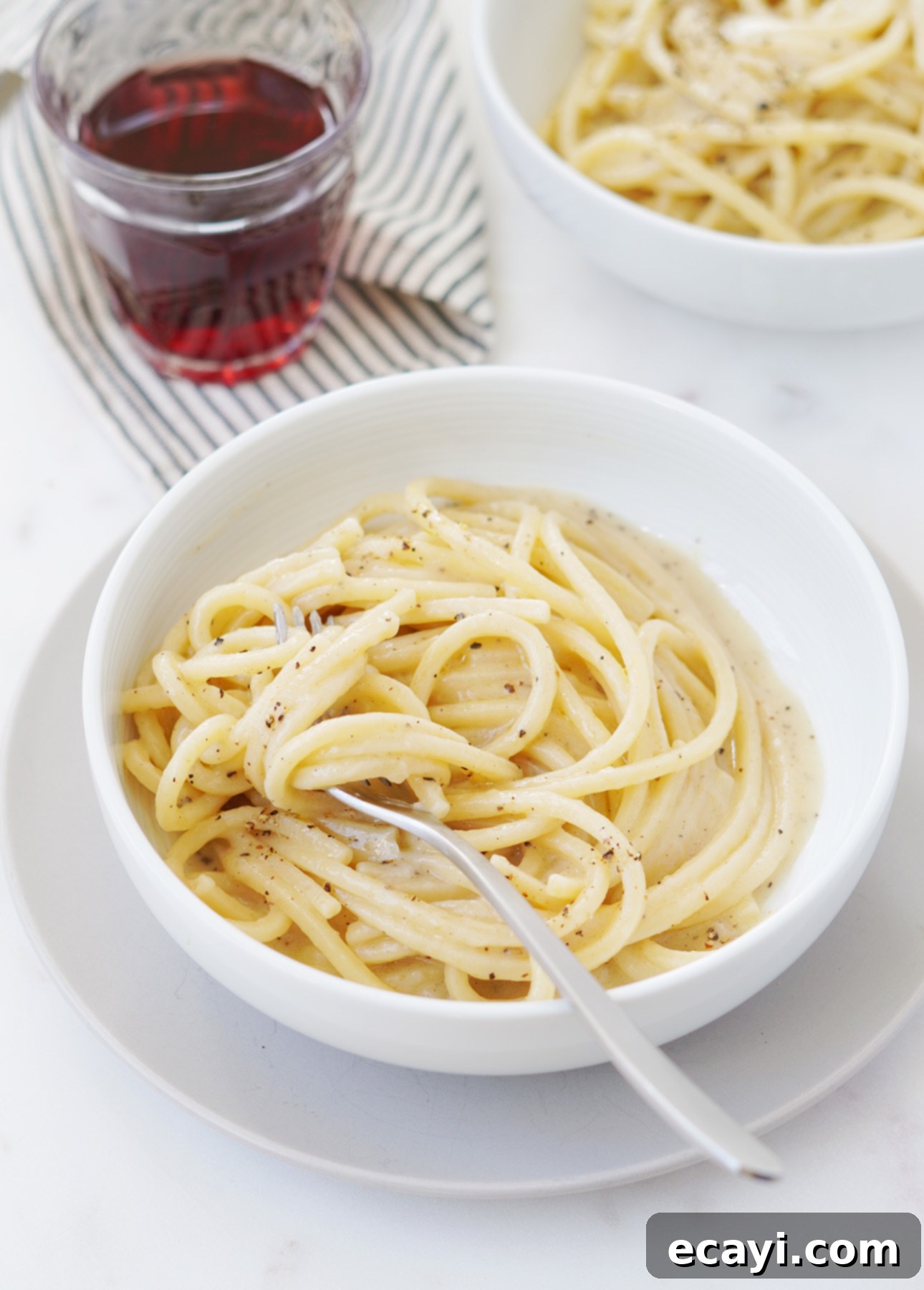
Discover More Authentic Italian Pasta Recipes!
If the simplicity and deliciousness of Cacio e Pepe have ignited your passion for Italian cuisine, you’ll be delighted to explore more easy and authentic Italian pasta dishes. These recipes are perfect for weeknight dinners, combining minimal ingredients with time-honored techniques to create irresistible meals that your entire family will adore. Find delicious inspiration and expand your Italian culinary repertoire in this curated pasta recipe collection!
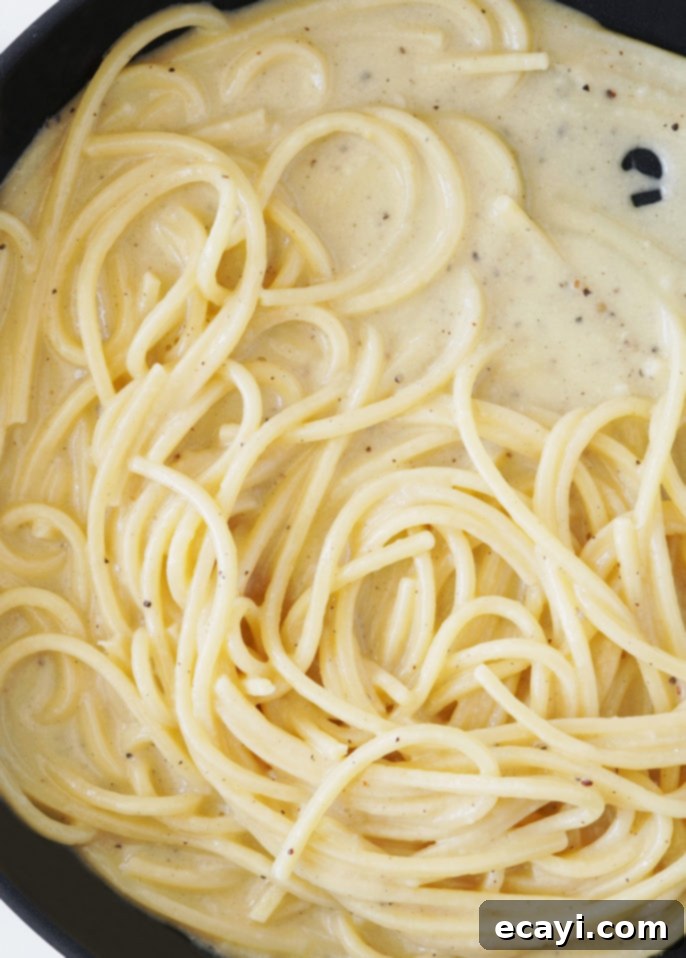
Pin Recipe
RECIPE: Perfect Cacio e Pepe Pasta
Ingredients
- 2 tbsp high-quality extra-virgin olive oil
- 1 tsp freshly coarsely ground black pepper (from whole peppercorns)
- 6 oz dry Spaghetti alla Chitarra (Tonnarelli) or quality spaghetti (ensure it’s bronze-cut and slow-dried for best results, see notes for details)
- 2 oz finely grated authentic Pecorino Romano cheese (grated with a Microplane)
To Serve
- Additional coarsely ground black pepper (for garnish)
- Additional finely grated Pecorino Romano cheese (for garnish)
Instructions
-
In a medium nonstick skillet (large enough to hold the pasta), gently heat the extra-virgin olive oil over medium heat. Add the coarsely ground black pepper and stir constantly for about 1 minute until it becomes fragrant and just begins to sizzle. This step toasts the pepper, enhancing its aroma. Immediately turn off the heat and set the skillet aside while you prepare your pasta.
-
Bring a large saucepan or pot of heavily salted water to a rolling boil. Add your chosen pasta and set a timer for precisely HALF the cooking time recommended on the pasta packaging. When the timer goes off, use kitchen tongs to carefully transfer the partly cooked pasta directly from the pot into the skillet with the pepper-infused olive oil. It is absolutely crucial NOT to discard the pasta water; you will need it shortly!
-
Return the skillet to medium-high heat. Add 1 cup of the reserved starchy pasta water to the pasta and black pepper mixture. Once the water begins to simmer actively, reduce the heat to medium. Continue to cook the pasta in the skillet, stirring frequently to prevent sticking and ensure even cooking, for the remainder of the cooking time as indicated on the pasta package. (For example, if the total cooking time is 12 minutes, and you cooked it for 6 minutes in the pot, you’ll now cook it for another 6 minutes in the skillet).
Throughout this process, the pasta should always be visibly simmering in liquid but not completely submerged. Add additional pasta water, a quarter cup at a time, as needed to maintain this level of liquid and ensure the pasta finishes cooking al dente and releases maximum starch.
-
Taste a strand of pasta to check its doneness. It should be al dente—tender but still with a slight, firm bite. If it tastes raw, continue cooking for a few more minutes, adding more pasta water if necessary. Once al dente, you are ready to incorporate the cheese.
The absolute key to achieving a perfectly smooth, clump-free sauce is to add the finely grated Pecorino Romano cheese VERY SLOWLY and GRADUALLY. Turn off the heat or reduce it to its lowest setting. Take a generous pinch of cheese and sprinkle it evenly over the entire surface of the pasta. Immediately begin stirring vigorously with a spatula, or use tongs to toss the pasta rapidly, until the cheese has completely melted and is fully incorporated into the sauce. Then, repeat this process, adding another pinch of cheese, stirring until melted, and continuing until all the cheese is incorporated.
Ensure there is always enough simmering liquid (starchy pasta water) in the skillet to facilitate the cheese melting smoothly. If the sauce becomes too thick or dry at any point, add a splash (1-2 tablespoons) of hot pasta water to loosen it up. Do not add too much water at once, or your sauce will become watery rather than creamy. This gradual, patient method, combined with constant motion, ensures proper emulsification.
-
The entire cheese incorporation process should ideally take about 2 minutes. Once all the cheese has been added and the sauce is beautifully creamy and uniform, turn off the heat completely. Give the pasta one final, good stir to ensure everything is perfectly combined, then immediately divide it among warm serving bowls. Garnish generously with additional finely grated Pecorino Romano cheese and a final sprinkle of freshly crushed black pepper for an aromatic flourish. Serve without delay.
-
A critical note on serving: Cacio e Pepe is a dish that demands immediate attention. The cheese sauce will rapidly thicken and “set” as it cools, diminishing its luxurious creaminess. For the optimal experience, ensure you and your guests are ready to enjoy it the moment it’s finished cooking. This dish truly waits for no one!
-
Choosing Your Pasta Wisely: The traditional pasta for Cacio e Pepe is Spaghetti alla Chitarra (also known as Tonnarelli). Its thick, square-shaped strands provide an ideal texture for clinging to the rich sauce. While it can be challenging to find in conventional supermarkets, it’s a staple in Italian grocery stores and easily found online.
Excellent substitutes include standard spaghetti (avoiding spaghettini, which is too thin) or other robust, long pastas like linguine and bucatini. The key is to select a pasta that cooks in approximately 12 to 14 minutes, as this ensures the right starch release.
For the absolute best results, prioritize bronze-cut pasta. Its rough, porous surface is engineered to absorb and hold onto the creamy cheese sauce perfectly. Even better still is pasta that is both bronze-cut and slow-dried, as this combination yields a pasta that not only holds sauce beautifully but also releases more starch, contributing to an even creamier, silkier, and more stable emulsion.
For a deeper dive into selecting the perfect pasta for your Cacio e Pepe, please refer to my detailed tips earlier in this article.
Video
Did you make this?
Tell me how you liked it! Leave a comment or take a picture and tag it with @foodnouveau on Instagram.
Disclosure Notice: This site is a participant in the Amazon Associates Program, an affiliate advertising program designed to provide a means for the site to earn fees by linking to Amazon and affiliated sites.
If you click on an affiliate link, I may earn advertising or referral fees if you make a purchase through such links, at no extra cost to you. This helps me create new content for the blog–so thank you! Learn more about advertising on this site by reading my Disclosure Policy.
